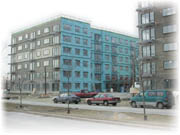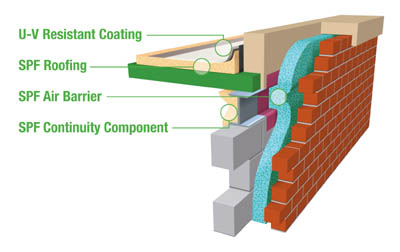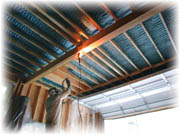Owners and developers are demanding higher performance buildings, so architects, specifiers and designers are looking for building materials that make a greater contribution to sustainability, durability, energy efficiency, and improved occupant comfort and safety. At the same time, they want these materials to have a low lifecycle cost, minimal environmental impact and the flexibility to allow design freedom.
Spray polyurethane foam is one of the insulation materials that can make significant contributions to improving return on investment, thanks to the versatility of polyurethane chemistry.

The chemistry of SPF
SPF is all about chemical cleverness. The material is a two-component product that is manufactured on-site but engineered in the molecular level to optimize performance for a specific application. The isocyanate (A-Component) is a designed molecule-not a distilled byproduct-that allows the chemist to manipulate it for an intended use. The isocyanate used for the manufacture of polyurethane coatings is designed to be different from that used for rigid insulation boards. The isocyanate used for board stock is designed to be different from that used for SPF. Their differences are engineered into the base molecule to yield a finished product designed specifically for optimum performance in its intended use.The resin (B component) is a combination of a dozen or so compounds. A single isocyanate can be matched with literally hundreds of different resins to create an SPF product engineered for the specific performance task. By varying key components within the resin, the finished product can be modified for roofing applications, insulating air barrier systems, adhesive applications or wall insulation, for both residential and industrial/commercial markets.
Three types of SPF are commonly used within the construction industry and offer different properties:
• medium-density (MD) 24 kg/m3 to 48 kg/m3 (1.5 pcf to 3.0 pcf)
• structural strength
• high moisture resistance
• high insulation values
• low-density (LD) 8 kg/m3 (less than 0.5 pcf)
• lower insulating value and moisture resistance sound control
• sealant foams
• continuity components
• gap and crack filling
Another consideration is whether the formulation is a closed-cell or open-cell foam. Medium-density SPF has a closed-cell content of greater than 90 percent and meets ASTM 1029/SPFA guidelines. Closed-cell formulations typically range in density from 27 kg/m3 to 51 kg/m3 (1.5 pcf to 3.0 pcf), while compressive strength ranges from 103 kPa to 345 kPa (15 psi to 50 psi). The density and composition of closed-cell foams can add structural integrity to the building. The industry has conducted tests that show 16-inch centered studs may be moved out to 48 inches and still maintain racking and structural loads according to code when incorporating MD closed-cell SPF. 4
Open-cell foams used for insulation have approximately 60 percent open-cell content and offer densities of 8 kg/m3 to 16 kg/m3 (0.5 pcf to 1 pcf) and compressive strengths of 28 kPa to 83 kPa (4 psi to 12 psi), adding minimal or no structural integrity. These products are performance upgrades from glass fiber materials, as they deliver a comparable R-value and some degree of air barrier performance as well.
R-values of closed-cell SPF used in air barrier, insulation and roofing applications with densities ranging from 24 kg/m3 to 51 kg/m3 (1.5 pcf to 3.0 pcf) typically range between 6.0 and 7.0 per inch. Low-density 8 kg/m3 (0.5 pcf), open-celled SPF typically has an aged R-value ranging from 3.4 to 3.6 per inch.
Both types are fully adhered and monolithic but open-cell foams have far greater air and vapor transmission characteristics. As such, these products do not qualify as air barriers as defined in ASTM International E 2178, "Standard Test Method for Air Permeance of Building Materials."
The choice between open-cell and closed-cell foams is usually made based on up-front cost versus thermal efficiency. Open-cell foams tend to provide a better yield than closed-cell foams, and installed costs for the same thickness, not R-value, are approximately 60 percent of those of closed-cell products. However, closed-cell foams offer far greater insulation (R-value) performance attributes that make important contributions to the lifecycle cost and sustainability of the building.

High-performance contributions
An estimated 54 percent of energy consumption in the United States is directly/indirectly related to buildings and their construction.1 The U.S. Department of Energy reports 40 percent of the energy cost of heating and cooling a building is wasted by uncontrolled air leakage through the building envelope.Although green building standards, such as Building for Environmental and Economic Sustainability, and Leadership in Energy and Environmental Design, do not specifically mandate or reward the use of air barrier systems in new construction (the term "air barrier" does not appear in the LEED NC V2.1 Rating System document; however, some industry experts feel that EA Prerequisite 2, EA Credit 1 and ID Credit 1 can or should involve the use of air barrier systems), Massachusetts mandates the use of air barriers in its Commercial Energy Code, and approximately 29 other states include air barriers in their provisional codes.
A groundbreaking report issued in June of this year by the National Institute of Standards and Technology evaluated the energy savings of an effective air barrier requirement for non-residential buildings in five American cities using the scalar ratio methodology employed by ASHRAE SSPC 90.1. The report states that:
"Despite common assumptions that envelope air leakage is not significant in office and other commercial buildings, measurements have shown that these buildings are subject to larger infiltration rates than commonly believed. Infiltration in commercial buildings can have many negative consequences, including reduced thermal comfort, interference with the proper operation of mechanical ventilation systems, degraded indoor air quality, moisture damage of building envelope components and increased energy consumption."2
The NIST study shows that the inclusion of an air barrier system in non-residential buildings can reduce air leakage by up to 83 percent to achieve a large reduction in energy consumption and operating costs, including potential gas savings of greater than 40 percent and electrical savings of greater than 25 percent.3
Canadian architects and builders have successfully used closed-cell SPF insulating air barriers for fifteen years on industrial, commercial and institutional buildings, both low- and high-rise. SPF air barrier systems use the versatility of polyurethane chemistry to combine superior insulation R-value with seamless, almost-zero air permeability for increased building energy efficiency, durability and occupant comfort, health and safety.
The Air Barrier Association of America approves the use of closed-cell SPF insulating air barrier systems to meet the 29 state commercial energy codes that meet or exceed ASHRAE 90.1-89, 'Energy Standard for Buildings Except Low-Rise Residential Buildings" and "ASTM International E 2178, Standard Test Method for Air Permeance of Building Materials."
Closed-cell SPF formulations can actually improve building durability. Results from testing conducted by the National Research Council of the Canadian Construction Materials Centre show SPF air barriers offering long-term durability greater than or equal to the building's life span. Testing conducted by the National Association of Home Builders Research Center shows SPF insulation between wood- and steel-stud wall panels increased rack and shear two to three times over standard stick-built components and glass fiber insulation when sprayed onto gypsum wallboard and vinyl siding, and increased racking strength by 50 percent when sprayed onto oriented strandboard.4

Economics and environmental responsibility
SPF systems feature a zero ozone-depleting blowing agent technology. Open-cell formulations usually use water as their blowing agent, which is replaced by air within a few days. Closed-cell formulations use zero-ozone depleting materials, such as HFC-245fa or proprietary products such as Honeywell's Enovate. All are approved under the Environmental Protection Agency's Significant New Alternatives Program. In addition, SPF emits no volatile organic compounds during installation or during occupancy.5Despite preconceived notions, chemistry can improve overall building performance and aid in improving ROI through energy savings and lifecycle costs. As consumers, we have a responsibility to investigate alternative insulation materials and systems, and demand that the most effective, environmentally sound products be used in our homes and buildings.
Knowing the types and properties of various formulations, along with their specific contributions and best applications, can help make the right decision when it comes to considering and selecting foam for a project.
Notes:
1 According to a 1998 report by GodfriedAugenbroe and Annie R. Pearce of
Georgia Institute of Technology.
2/3 Investigation of the Impact of Commercial Building Envelope Airtightness on HVAC Energy Use, Emmerich, McDowell, Anis, National Institute of Standards and
Technology (NIST), 2005.
4 Canadian Construction Materials Centre (CCMC), Evaluation Report 12932-R,
National Research Council (NRC) of Canada.
5 Air Barrier Association of America
(www.airbarrier.org)

Report Abusive Comment